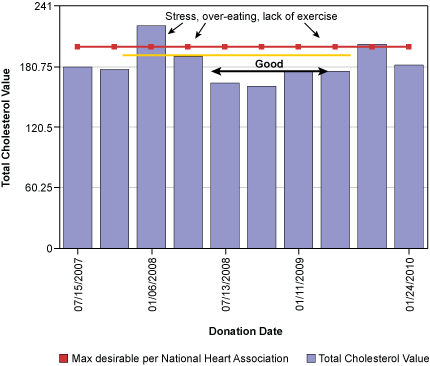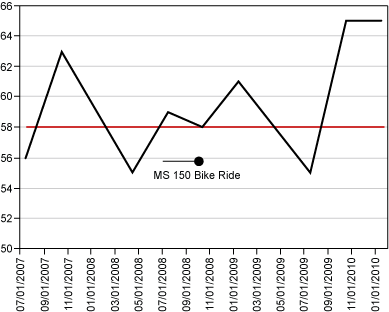
Four times a year, I donate blood at a local blood bank and receive readings on my cholesterol, blood pressure and pulse. Although donating blood does not improve a person’s health, the regular readings of the vital signs, along with analysis and actions stemming from this data, can be significant in the fight against heart disease, strokes and other medical problems.
Six Sigma practitioners, because of their knowledge of statistical analysis and their belief in continuous improvement, are at a particular advantage for using this health data to make positive life changes. For instance, practitioners can conduct regression analysis to show a correlation of the vital sign variables and the relationship to exercise and diet. Also, they can use time-phasing process to find leading indicators. Six Sigma concepts and tools have already proven useful in practitioners’ professional lives – but the concepts and tools also can be beneficial in practitioners’ personal lives.
Collecting Data
Heart disease, related to high cholesterol or elevated blood pressure, can affect anyone – young, old, male, female. Uncontrollable factors, such as one’s heredity, as well as controllable factors (diet, weight, exercise, stress) influence a person’s cholesterol and blood pressure.
Cholesterol
After each blood donation, the San Diego Blood Bank (SDBB) provides data on my cholesterol and blood pressure via a secure website. Having this data available every three months helps me monitor and improve my health. High blood pressure is referred to as the silent killer because the symptoms may not be apparent. One in three Americans suffers from high blood pressure.
Figure 1 is a chart of my cholesterol. Although the National Heart Association recommends maintaining a cholesterol level of 200 (the red line) or below, my goal is to stay under 180 (the yellow line).

For me, exercise and healthy eating significantly lower my cholesterol levels. As illustrated in Figure 1, my July 2008 and October 2008 cholesterol levels were favorable. I recall that I was eating right and exercising in preparation for a Multiple Sclerosis bike ride held in October 2008. I remember starting this exercise and eating routine after my January 2008 physical and January blood donation results.
There were three periods in which I missed my goal of keeping my total cholesterol value below 180 (Jan 2008, April 2008 and October 2009); these were periods preceded by stress, overeating and minimal exercise.
Blood Pressure
The SDBB also provides blood pressure readings, which I downloaded to create Figure 2. The red and orange lines are my blood pressure. My goal is to keep the systolic blood pressure under 120. Fortunately, I was born with good genes for low (good) blood pressure.

The data shows that cholesterol value could be a leading indicator of blood pressure for me, as illustrated by the dotted green lines. For example, my cholesterol peaked in Jan. 2008 (bad) and my blood pressure peaked (bad) three months later (April 2008). Likewise, my cholesterol was good in July 2008 and my blood pressure was good three months later (Oct. 2009).
Regression Analysis
After noticing the relationship between my cholesterol and blood pressure levels, I conducted a mathematic regression analysis, which provided the same results.
With the original data, a regression analysis on blood pressure (systolic) to cholesterol showed no correlation; the coefficient of correlation is near zero (0 is no correlation, weak is .25, moderate is .50, strong is .75, perfect is 1.0).
However, when blood pressure is shifted three months backward, the coefficient of correlation is .58 (moderate to strong). The coefficient of determination, or the proportion of the total variation in blood pressure attributed to the cholesterol reading, is 34 percent in this situation. These calculations can easily be produced in Excel using the data analysis add-in.
Although this shows a mathematical correlation of blood pressure to cholesterol, correlation does not prove the causal relationship. Both blood pressure and cholesterol levels could be independently influenced by my exercise and eating routine. The mathematical exercise does reinforce that something happened as both variables changed, somewhat in tandem with the time shift. The analysis could also imply, at least with this data, the predictive nature of blood pressure by cholesterol; that is, cholesterol as a leading indicator.
Leading Indicators
The other lesson is that of leading indicators. When presented with data, such as that in Figure 2, practitioners should look for the phasing relationship, as indicated by the green lines. Many times there is correlation of the variables if the timeframe of one or more variables is shifted. There are mathematical means of determining a phasing relationship, but for many applications, simple charting and shifting data up or down in a spreadsheet is sufficient. More data and examples are needed to make a conclusion on a leading indicator and the causal relationship.
Pulse is another good health indicator. Years ago I read that a heart will have so many beats in a lifetime. When people exercise vigorously, their hearts beat faster per minute. However, the exercise builds up the heart from a muscular perspective, such that when they are not exercising (which is most of the time), the heart beats slower, thus providing a long heart life. As illustrated in Figure 3, my improved (lower) pulse rate correlates to those times when I exercise more. My goal is keep my pulse in the 60 beats per minute range.

Personal Takeaways
At age 61, my key takeaway is to eat healthy, avoid refined sugars and minimize fat. Avoiding salt and minimizing alcohol also are good practices. Minimizing fast food and processed food helps in this endeavor. Walking, hiking, and cycling are my favorite types of exercise and, as correlated to the charts, contribute to better health conditions.
Another important factor that goes with the healthy eating and exercises is weight control, which, for me, is a struggle. There are good medications that reduce cholesterol and blood pressure; however, my goal is try to avoid these as long as possible due to the dependency, cost and side effects. Fortunately, I have been blessed with good health.
Each year I get a physical from a primary care physician. There are a number of ways to manage heart disease once it is diagnosed; however, frequent monitoring, trending and taking proactive measures for disease prevention are limited. Once a year measurements are limited in terms of trending, providing body knowledge and creating focus. The quarterly vital sign updates I receive after donating blood help to fill the gaps.
Six Sigma Advantage
Every person is different. There is a tendency for people to compare their results to others or to averages. Or, people sometimes conclude that they can’t change their health condition. Six Sigma practitioners, however, know that this is not the right attitude. By approaching problems in an objective way, applying systems thinking and excluding the personalization of problems, it is possible to make continuous improvements. Data, although good, does not, by itself, change things. Decisions must be made based on both emotional and logical factors.
Behavioral change is difficult. Dr. Edwards Deming, the statistician and quality guru, developed 14 principles on quality and change to help with people and the emotion challenge. The applicable Deming principles include:
- No. 1: Have a constancy of purpose.
- No. 14: Take action on the transformation.
- No. 5: Improve the system constantly.
- No. 11: Eliminate numerical quotas.
The last principle about numerical quotes may seem contradictory, as Dr. Deming used so many charts and graphs. But his emphasis was on measuring and improving the process, and not judging the person. Healthcare is personal; cholesterol, blood pressure and weight numbers are your numbers. However, when Six Sigma practitioners approach the change as a process and system, it can help them to address the problem more directly and objectively.
“You can’t improve what you can’t measure” is a common concept in business quality management and Six Sigma. Charting data, monitoring trends, finding correlation and taking action (the Plan, Do, Check, Act cycle) can also be applied to personal health. Practitioners should challenge themselves to look for opportunities to apply Six Sigma concepts, grow the body of knowledge and share with others. And, if you are able to donate blood, check out the local blood bank. There is always a pressing need for blood and the personal health data every three months can be beneficial to your health.
Note that the information provided is based on personal experience and data. This article is not intended to be a substitute for professional medical advice.